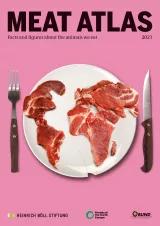
Intensive livestock production creates environmental and animal welfare problems. Reforms currently being considered to the EU’s Common Agricultural Policy do not go nearly far enough to resolve these. But improvements can be made even within the current system.

At 40 percent, livestock account for a big chunk of the value of the EU’s agricultural output. The importance of livestock varies from one member state to another: from 21 percent in predominantly arable Romania, to 75 percent in Ireland with its many sheep and cattle. The number of animals per unit of area also differs, along with the problems associated with high stocking rates. The Netherlands has a high concentration of livestock, along with northern Italy and the northwestern parts of Germany and France.
Such concentrations lead to environmental problems, such as nitrogen and phosphorus pollution in water. Producing and consuming a lot of meat, milk and eggs emits significantly more greenhouse gas compared to diets based on plants. And animal welfare problems are widespread. There are no systematic, EU-wide surveys, but individual studies point to common health issues: joint diseases and tail biting in pig-fattening operations, lameness in cattle, and foot problems in poultry.
Surveys show that 82 percent of EU citizens think that more should be done to protect animal welfare in livestock production. This sentiment is widely shared across Europe – from a sizeable majority of 58 percent of respondents in Luxembourg to a near-unanimous 94 percent in Portugal. But doing more to protect animals would not be cheap: the Scientific Advisory Council for Agricultural Policy, a body attached to the German Ministry of Food and Agriculture, estimates that significant improvements in animal welfare would cost between 3 and 5 billion euros a year in Germany alone. That is between 13 and 23 percent of current production costs.
Both production and consumption should be reduced to lower emissions of greenhouse gases. This is especially important with ruminants, which produce a lot of emissions per kilo of meat or litre of milk produced. A political and economic strategy that recognizes the scale of these challenges does not yet exist, either at the EU level or in any of the member states. Large differences in livestock production and consumption between countries mean that planning and implementing such a strategy must be the task of governments in each member state. The Common Agricultural Policy would have to provide a suitable framework for such an effort.
The Common Agricultural Policy consists of two “pillars”. Pillar I makes direct payments to farmers and is tied mainly to the area farmed, not to the services that farming provides. Pillar II, which covers rural development, offers the possibility of granting annual premiums to farmers for animal-friendly management. This can include providing grazing areas, allowing animals more space for movement, and enriching their environment – providing pigs with deep straw bedding or bales to keep them occupied, for example. But this flexibility is in fact rarely used. Between 2014 and 2020, only 1.5 percent of the Pillar II funds, or 205 million euros a year, were spent on animal welfare premiums. Even in welfare-conscious Germany, the figure was below 2 percent. That contrasts with area subsidies of 40 billion euros for the EU as a whole.
This comparison shows how poorly the EU’s farm budget is geared to the services that agriculture provides and the problems that it faces. Livestock farmers are up against particularly great challenges, with increasing obligations to protect groundwater and surface water, the climate, biodiversity and animal welfare. These requirements cannot be met merely by imposing more rules and regulations. Doing so would lead to significantly higher production costs and the increased import of cheap products from countries that do not have such stringent controls. That would negate the intended environmental and animal welfare benefits by shifting the problems abroad. The Common Agricultural Policy budget should be urgently reformed to reward compliance with the requirements and to cover part of the costs of doing so. Instead, a large part of the budget goes towards flat-rate subsidies on land. In many member states, it is also spent on coupled payments for ruminants, such as suckler cows.
Unfortunately, negotiations among the key EU level decision-makers – the European Parliament, Council and Commission – did not result in a fundamental shift away from flat-rate subsidies tied to land area. But even with the current post-2021 CAP, member states have many options to target the budget towards supporting animal welfare and environmental services provided by farms.
First, to ensure that more money is available to pay for services, member states can shift up to 25 percent from direct payments to Pillar II for agri-environmental and animal welfare programs. Second, eco-schemes in Pillar I and conditionality can be designed ambitiously. Third, the possibility to link part of the direct payments to production should aim strictly at animal welfare and environmental protection measures, such as the maintenance of grazing areas. Such payments should be based on grazed land and not bound to animal numbers or specific species. In conclusion, member states can and should not hide behind CAP regulations, but make full use of existing flexibility to target the money towards societal objectives.

